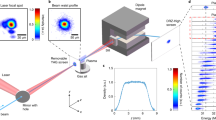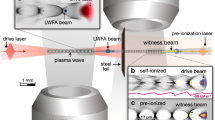Abstract
The energy frontier of particle physics is several trillion electron volts, but colliders capable of reaching this regime (such as the Large Hadron Collider and the International Linear Collider) are costly and time-consuming to build; it is therefore important to explore new methods of accelerating particles to high energies. Plasma-based accelerators are particularly attractive because they are capable of producing accelerating fields that are orders of magnitude larger than those used in conventional colliders1,2,3. In these accelerators, a drive beam (either laser or particle) produces a plasma wave (wakefield) that accelerates charged particles4,5,6,7,8,9,10,11. The ultimate utility of plasma accelerators will depend on sustaining ultrahigh accelerating fields over a substantial length to achieve a significant energy gain. Here we show that an energy gain of more than 42 GeV is achieved in a plasma wakefield accelerator of 85 cm length, driven by a 42 GeV electron beam at the Stanford Linear Accelerator Center (SLAC). The results are in excellent agreement with the predictions of three-dimensional particle-in-cell simulations. Most of the beam electrons lose energy to the plasma wave, but some electrons in the back of the same beam pulse are accelerated with a field of ∼52 GV m-1. This effectively doubles their energy, producing the energy gain of the 3-km-long SLAC accelerator in less than a metre for a small fraction of the electrons in the injected bunch. This is an important step towards demonstrating the viability of plasma accelerators for high-energy physics applications.
This is a preview of subscription content, access via your institution
Access options
Subscribe to this journal
Receive 51 print issues and online access
$199.00 per year
only $3.90 per issue
Buy this article
- Purchase on Springer Link
- Instant access to full article PDF
Prices may be subject to local taxes which are calculated during checkout



Similar content being viewed by others
References
Tajima, T. & Dawson, J. M. Laser electron accelerator. Phys. Rev. Lett. 43, 267–270 (1979)
Chen, P. et al. Acceleration of electrons by the interaction of a bunched electron beam with a plasma. Phys. Rev. Lett. 54, 693–696 (1985)
Joshi, C. et al. Ultrahigh gradient particle acceleration by intense laser-driven plasma density waves. Nature 311, 525–529 (1984)
Modena, A. et al. Electron acceleration from the breaking of relativistic plasma waves. Nature 377, 606–608 (1995)
Gordon, D. et al. Observation of electron energies beyond the linear dephasing limit from a laser-excited relativistic plasma wave. Phys. Rev. Lett. 80, 2133–2136 (1998)
Umstadter, D. et al. Nonlinear optics in relativistic plasmas and laser wake field acceleration of electrons. Science 273, 472–475 (1996)
Mangles, S. P. D. et al. Monoenergetic beams of relativistic electrons from intense laser–plasma interactions. Nature 431, 535–538 (2004)
Geddes, C. G. R. et al. High-quality electron beams from a laser wakefield accelerator using plasma-channel guiding. Nature 431, 538–541 (2004)
Faure, J. et al. A laser–plasma accelerator producing monoenergetic electron beams. Nature 431, 541–544 (2004)
Barov, N. et al. Propagation of short electron pulses in a plasma channel. Phys. Rev. Lett. 80, 81–84 (1998)
Hogan, M. J. et al. Multi-GeV energy gain in a plasma-wakefield accelerator. Phys. Rev. Lett. 95, 054802 (2005)
Katsouleas, T. Physical mechanisms in the plasma wake-field accelerator. Phys. Rev. A. 33, 2056–2064 (1986)
Bruhwiler, D. et al. Particle-in-cell simulations of tunneling ionization effects in plasma-based accelerators. Phys. Plasmas 10, 2022–2030 (2003)
Rosenzweig, J. B. et al. Acceleration and focusing of electrons in two-dimensional nonlinear plasma wake fields. Phys. Rev. A. 44, R6189–R6192 (1991)
Clayton, C. E. et al. Transverse envelope dynamics of a 28.5-GeV electron beam in a long plasma. Phys. Rev. Lett. 88, 154801 (2002)
Dodd, E. S. et al. Hosing and sloshing of short-pulse GeV-class wakefield drivers. Phys. Rev. Lett. 88, 125001 (2002)
Bane, K. L. F. & Emma, P. LiTrack: a fast longitudinal phase space tracking code with graphical user interface. Stanford Linear Accelerator Center Report No. SLAC-PUB-11035 (SLAC, Menlo Park, California, 2005)
Huang, C. et al. QUICKPIC: A highly efficient particle-in-cell code for modeling wakefield acceleration in plasmas. J. Comput. Phys. 217, 658–679 (2006)
Johnson, D. K. et al. Positron production by X rays emitted by betatron motion in a plasma wiggler. Phys. Rev. Lett. 97, 175003 (2006)
Krejcik, P. et al. Commissioning of the SPPS linac bunch compressor. Proceedings of the Particle Accelerator Conference (12–16 May, 2003, Portland, Oregon) 423–425 (IEEE, Piscataway, New Jersey, 2003)
Muggli, P. et al. Photo-ionized lithium source for plasma accelerator applications. IEEE Trans. Plasma Sci. 27, 791–799 (1999)
Ammosov, M. V. et al. Tunnel ionization of complex atoms and of atomic ions in an alternating electromagnetic field. Sov. Phys. JETP 64, 1191–1194 (1986)
Acknowledgements
This work was supported by the US Department of Energy and the National Science Foundation.
Author information
Authors and Affiliations
Corresponding author
Ethics declarations
Competing interests
Reprints and permissions information is available at www.nature.com/reprints. The authors declare no competing financial interests.
Supplementary information
Supplementary Discussion
This file contains Supplementary Discussion of why the defocusing forces arise later in time and how they affect the accelerating electrons and Supplementary Figures 1-4 with Legends. (PDF 1370 kb)
Supplementary Movie
This file contains a movie from a 3D simulation showing the evolution of the density of plasma electrons (left pane in Movie) and of the density of beam electrons (right pane in Movie) as the beam propagates through 97cm of initially neutral lithium vapour. Head erosion and phase mixing are evident (MOV 4895 kb)
Rights and permissions
About this article
Cite this article
Blumenfeld, I., Clayton, C., Decker, FJ. et al. Energy doubling of 42 GeV electrons in a metre-scale plasma wakefield accelerator. Nature 445, 741–744 (2007). https://doi.org/10.1038/nature05538
Received:
Accepted:
Issue Date:
DOI: https://doi.org/10.1038/nature05538
This article is cited by
-
Generation of ultrahigh-brightness pre-bunched beams from a plasma cathode for X-ray free-electron lasers
Nature Communications (2022)
-
Direct observation of relativistic broken plasma waves
Nature Physics (2022)
-
Free-electron lasing with compact beam-driven plasma wakefield accelerator
Nature (2022)
-
A step closer to compact X-ray lasers
Nature (2021)
-
Monitoring the size of low-intensity beams at plasma-wakefield accelerators using high-resolution interferometry
Communications Physics (2021)
Comments
By submitting a comment you agree to abide by our Terms and Community Guidelines. If you find something abusive or that does not comply with our terms or guidelines please flag it as inappropriate.



